#fossil fish bones
Explore tagged Tumblr posts
Photo

Fossil Fish Bones in Coprolite Bed Matrix – Westbury Formation, Upper Triassic, Aust Cliff UK – Genuine UK Fossil with COA
This listing is for an exceptional specimen of fossil fish bones preserved in matrix, collected from the famous fish, reptile and coprolite bed at Aust Cliff, near Bristol, UK. This matrix originates from the Westbury Formation, part of the Penarth Group, dating back to the Upper Triassic period—approximately 205 million years ago.
The specimen contains clear fossilised fish bone fragments, showcasing the excellent fossil preservation quality for which this horizon is renowned. The Westbury Formation at Aust Cliff is famous globally among palaeontologists for its wealth of vertebrate fossils, including remains of fish, marine reptiles, coprolites, and even dinosaur material.
Your specimen was discovered by our experienced field team, Alister and Alison, on 07 April 2025, and has been expertly cleaned, prepped, and stabilised by Alison to reveal its fossil content with care and precision.
Geological Information:
Fossil Type: Fish bones (possibly from genera such as Saurichthys, Birgeria, or similar Triassic taxa)
Formation: Westbury Formation
Group: Penarth Group
Age: Upper Triassic (Rhaetian Stage)
Location: Aust Cliff, Bristol, England
Depositional Environment: Coastal marine lagoonal mudstone – shallow, anoxic marine conditions ideal for preservation
Biozone: Within the Psiloceras planorbis ammonite biozone (used for dating overlying beds)
Notable Features:
Genuine UK vertebrate fossil from a classic heritage site
Appears in original matrix from the fossil bed
Ready for study, display or collection
Each fossil is unique and the photo shows the actual specimen you will receive. Scale cube = 1cm. Please refer to the photo for full sizing.
100% Genuine Specimen – Certificate of Authenticity Included
All of our fossils are carefully selected, professionally prepared, and guaranteed to be 100% genuine. This item comes with a Certificate of Authenticity for your peace of mind.
A great addition for any fossil collector, educational display, or natural history enthusiast!
If you need a bundled listing with similar fossils from this bed (e.g., reptile bones, coprolites, or teeth), feel free to reach out!
#Fossil fish bones#Triassic fossil#Aust Cliff fossil#Westbury Formation#Penarth Group#fish fossil UK#coprolite bed fossil#British fossil#authentic fossil#Upper Triassic vertebrate#prehistoric fish remains#UK fossil bones#fossil matrix#fossil fish bone specimen#fossil collectors UK
0 notes
Note
You’re such a nerd, ICANT dude 😂😂
HAHA y’all have no idea of the extent of my nerdiness 😭
#i grew up on a ____ farm (can’t risk details) but the process of selling out products#means there are giant holes in the ground#and i fucking love just getting into those holes and looking at the soil horizons#like !!!! i’ve found these huge chunks of gypsum in the soil#and some very cool fossils (fish bones and shark teeth)#i just love to learn#and i also love pokemon and baldur’s gate 3 which i am playing for the very first time rn#talk#ask
83 notes
·
View notes
Text

I guess it’s time to stop hoarding the good ones 🤣….
$175
#skull#curiosities#animal skull#antlers#bird hunting#bone hunting#deer skull#deer hunting#fossil hunting#fishing#hunting#shed antler#shed hunting#deadhead
4 notes
·
View notes
Text
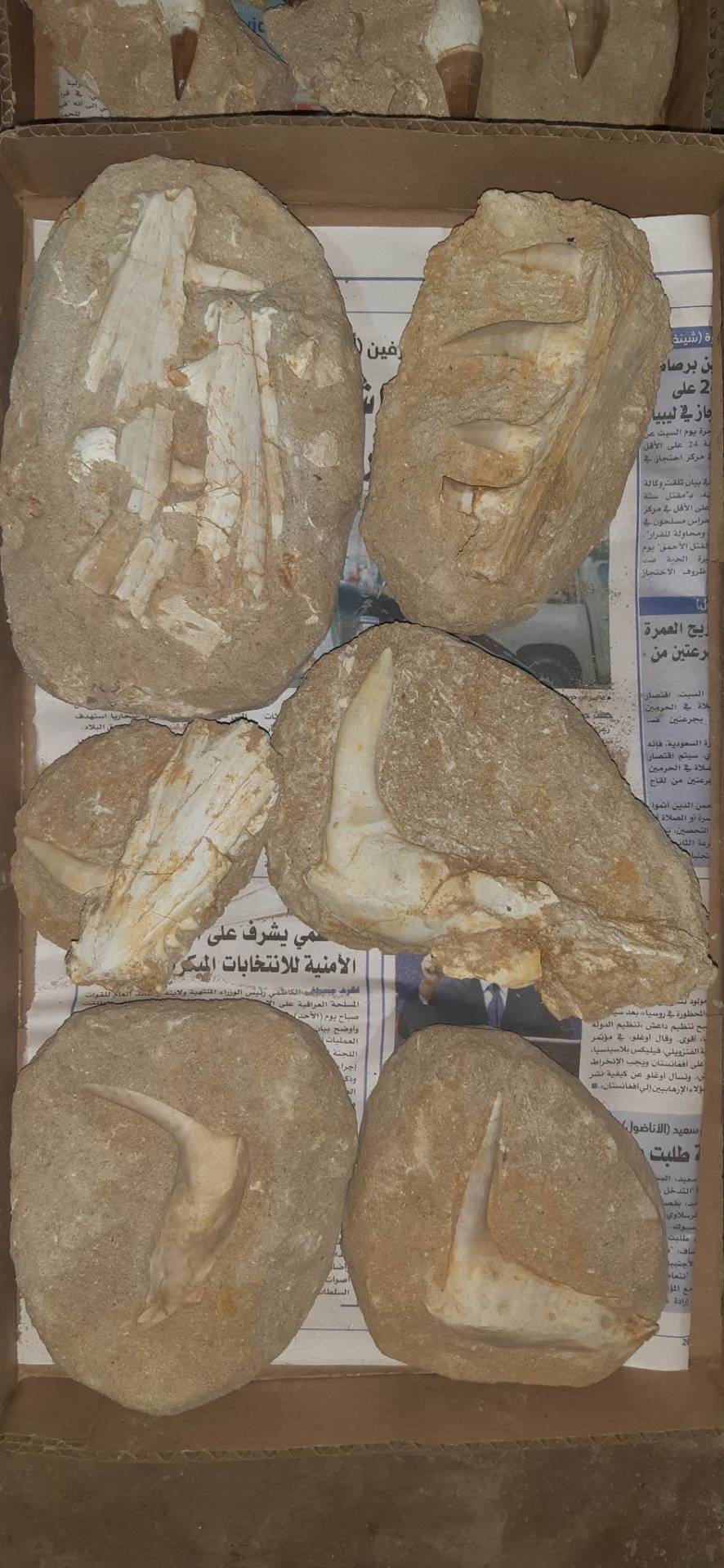
Enchodus fossil fish bones
8 notes
·
View notes
Text
*Propaganda, fun facts, and owl pics under the cut
BARN OWL:

Last year's winner and our current reigning champion, the Barn Owl is back to defend their title! What makes the Barn Owl so popular? Their haunting face? Their screeching cries? Their vast range - nesting on every continent save Antarctica, vastly increasing their chance of being your local owl? Only you can say! And only you can secure the Barn Owl's victory for another year!
PYGMY OWL:

Meet the pygmy, an owl species so small that they are better called owlets! Don't underestimate these hunters, they're locked in a standing war with the songbirds - the owls swallowing the songbirds up and the songbirds retaliating by mobbing the owls in large flocks.
SNOWY OWL:

Known by many names: the polar owl, white owl, and Arctic owl among them, this is the largest North American owl by weight. Most snowy owls are barred with dark brown markings (like the one pictured here). If you see a pure white owl, it's a sure sign you've found a mature male.
EURASIAN EAGLE OWL:

Swooping in to riotous demand, behold the Eurasian Eagle Owl!
To all those mortally offended by the accidental exclusion of the Eurasian Eagle Owl last year, please accept this offering, of a link to Episode 100 of the very excellent podcast Beyond Blathers, bringing you 48 delightful minutes of Eurasian Eagle Owl facts and stories:
SAW-WHET OWL:

The most common owl in North American forests, the saw-whet owl calls through the evening skies with a high-pitched call like a saw being sharpened on a whet stone - hence the name.
SPECTACLED OWL:

The smart-looking Spectacled Owl makes its home in mature rainforest, though they have been known to venture into the desert for food. You'll know these owls by sight, thanks to their distinctive mask, and by sound, making a vibrating call like someone shaking a thin sheet of metal.
SCREECH OWL:

As the name suggests, you'll hear these owls before you see them, and you might think you're being haunted if you do! You might also be able to track them by their owl pellets - regurgitated packets of undigestable bones, fur, and feathers - littered around their nesting sites.
BARRED OWL:

You'll know Barred Owls when you hear them, calling "Who cooks for you? Who? Who? Who cooks for you?" through the dark of night. Compared to other owls, Barred Owls don't migrate. Fossils of this bird dating back 11,000 years have been found in Ontario
GREAT HORNED OWL:

Also called a tiger owl, a winged tiger, or a tiger of the air, these birds are fierce predators, capable of besting other raptors - including the barred owl. They are so strong, that it takes 28lbs of force to open their claws.
BURROWING OWL:

As the name suggests, these owls prefer nesting in the abandoned burrows of other underground-dwelling animals to roosting in the trees! though their nests may be pre-owned, these owls have been known to decorate with bottle caps and bits of foil or paper. By the same grounded preference, you're more likely to spot one running after its prey than flying, making good use of their long legs.
LONG-EARED OWL:

With a permanent expression of someone who just caught got doing something they're not supposed to, these owls are indeed sneaks, opting to claim nests built by others rather than constructing their own. But for all their sneaky ways, Long Eared Owls are among the friendliest, roosting in groups of up to 150 members.
BLACKISTON'S FISH OWL:

Standing at 70cm tall, the Blakiston's Fish Owl reigns in Northeast Asia as the largest living owl on earth. True to their name, they eat mostly fish and have no trouble diving from the skies in pursuit of a trout, pike, salmon.
#Spotify#superb owl#Superbowl#Superb Owl Competition#Superb Owl Competition 2025#polls#tumblr polls#owl#owls#superbowl 2025#wwdits#fun polls#poll
688 notes
·
View notes
Photo

Fossil Chalk Fish Bones Cretaceous Grey Chalk Osteichthyes Sussex UK Genuine Specimen
Fossil Chalk Fish Bones – Osteichthyes
Geological Period: Cretaceous (Late)
Age: Approximately 100 to 66 million years ago
Formation: Grey Chalk Subgroup
Locality: Clyde, Sussex, United Kingdom
This listing presents a fascinating fragment of fossilised fish bones from a bony fish (class Osteichthyes), embedded in the iconic Grey Chalk of southern England. Recovered from Clyde, Sussex, this specimen dates to the Late Cretaceous, a time when much of the UK was submerged beneath a shallow, warm sea.
The Grey Chalk Subgroup is part of the broader Chalk Group, deposited during the Late Cretaceous and composed primarily of coccolith-rich calcareous sediments. These marine chalks frequently yield well-preserved micro- and macrofossils, including the remains of fish, marine reptiles, ammonites, and echinoderms.
Fish remains from this unit, including bones, scales, and teeth, are relatively scarce and often highly fragmented, making well-preserved examples like this a prized find. The bones may include partial vertebrae, fin rays, or cranial fragments — each offering insights into the structure and diversity of ancient marine vertebrates.
Actual Specimen Pictured: You will receive the exact item shown in the photo.
Scale: 1cm cube included for accurate sizing. Please see image.
Condition: Natural preservation in matrix; stable and suitable for display or study.
Ideal for:
Fossil collectors and palaeontology enthusiasts
Educational settings and museum reference
Marine fossil displays
Gifts for natural history lovers
All of our Fossils are 100% Genuine Specimens & come with a Certificate of Authenticity.
Our fossils are responsibly sourced and described with detailed geological and taxonomic accuracy.
#fossil fish bones#chalk fish fossil#Cretaceous fish remains#Grey Chalk Formation#Sussex fossil#Clyde UK fossil#bony fish fossil#Osteichthyes fossil#British fossil fish#authentic chalk fossil#real fish bones#Mesozoic marine fossil#UK fossil vertebrate#fish bone slab#genuine Cretaceous fossil
0 notes
Text
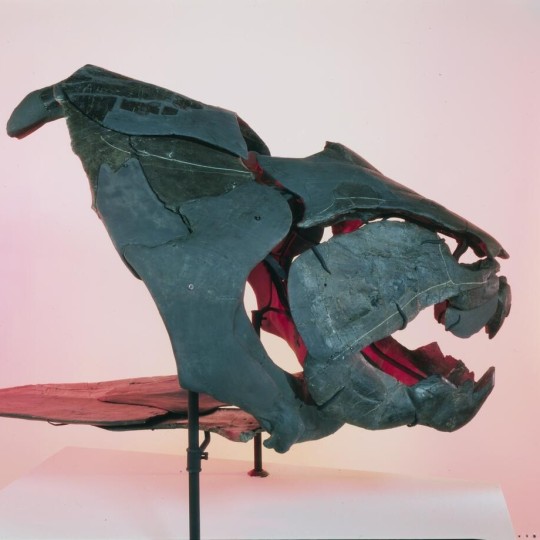
Don’t mess with this fish! For Fossil Friday, let’s meet Dunkleosteus terrelli. It lived some 360 million years ago during the Devonian. Scientists think it was one of the first large jawed vertebrates in the ocean and an aggressive predator. The razor-sharp edges of bones in its jaws served as cutters, and as they rubbed against each other, the opposing jaw blades acted like self-sharpening shears. These bones continued to grow as they were worn down by use.
This specimen, on display in the Museum’s Hall of Vertebrate Origins, was found in Ohio. Spot Dunkleosteus and other prehistoric animals at the Museum! Plan your visit.
Photo: Image no. ptc-5861 © AMNH Library
#science#amnh#museum#fossil#nature#natural history#animals#fact of the day#did you know#fish#fossil friday#fossil fish#prehistoric#devonian#museums#american museum of natural history#museum of natural history#natural history museum#paleontology
710 notes
·
View notes
Text

In the late 18th century a strange fish fossil from the Monte Bolca deposits in northern Italy was described and named as Pegasus volans. This name had actually already been assigned to the living longtail seamoth (today known as Pegasus volitans), but despite this the fossil continued to be referred to as "Pegasus volans" for well over 200 years.
Now, finally, it's been redescribed and given a proper genus name of its own: Dibango volans.
Living during the early Eocene, around 50-48 million years ago, in what was then a warm shallow reef in the western Tethys Ocean, Dibango was probably around 7-10cm long (~3–4"). It had a long flag-like first ray of its dorsal fin, a very reduced and compact abdominal region, an extremely elongated pelvic bone that appears to have supported an exterilium (external gut), long pelvic fins, and a long slender tail.
This bizarre combination of features is often seen in fish larvae, but Dibango's level of skeletal development shows it was fully grown – suggesting it was actually an unusually neotenic fish, retaining its larval anatomy all the way into adulthood.
This also makes it very difficult to figure out what kind of fish it actually was, with the current best guess being "some sort of percomorph".
———
NixIllustration.com | Tumblr | Patreon
References:
Davesne, Donald, and Giorgio Carnevale. "An enigmatic teleost fish from the Eocene of Bolca (Italy) with unusual larval‐like features." Papers in Palaeontology 11.3 (2025): e70017. https://doi.org/10.1002/spp2.70017
Volta, Giovanni Serafino, et al. "Ittiolitologia veronese del Museo Bozziano: ora annesso a quello del Conte Giovambattista Gazola e di altri gabinetti di fossili veronesi; con la versione latina." Verona, Italy: Dalla Stamperia Giuliari (1796). https://www.biodiversitylibrary.org/bibliography/163554
Wikipedia contributors. “Dibango volans” Wikipedia, 20 May 2025, https://en.wikipedia.org/wiki/Dibango_volans
#science illustration#paleontology#paleoart#palaeoblr#dibango#percomorpha#actinopterygii#fish#art#neoteny
345 notes
·
View notes
Text

Pteranodon - a large Late Cretaceous pterosaur with wingspans over 6 meters. Known for its sexual dimorphism, males had long, backward-facing crests and were significantly larger than females, whose crests and body sizes were smaller. Interestingly, not all males had large crests; only the largest, fully mature males displayed them. With female fossils outnumbering males 2:1, Pteranodon was likely polygynous, with dominant males mating with multiple females that took care of young, like elephant seals.

Pteranodon lacked teeth, a trait shared by many large Cretaceous pterosaurs. As a piscivore, it fed mainly on fish. Strong neck muscles and the ability to take off from water suggest it hunted by diving, similar to modern seabirds like pelicans and gannets.


With light bones and long wings, Pteranodon was adapted for dynamic and thermal soaring, enabling it to cover great distances with ease. This efficient flight likely expanded its hunting grounds and may have facilitated migration, similar to modern storks and condors.

449 notes
·
View notes
Text







Nice Real Wolverine Skull
Cleaned Minor Flaws
$125
#curiosities#animal skull#antlers#bird hunting#bone hunting#deer hunting#deer skull#fishing#fossil hunting#fur#taxidermy#bone art#skull art#skull collecting#mystery skulls
5 notes
·
View notes
Text
"Statistically Speaking"
A Criminal Minds one-shot | Spencer Reid x Reader | Part I


A museum trip leads to an unexpected, adorable connection with Dr. Spencer Reid.
w/c 936 (short n sweet - may do a pt 2?)
...
You weren’t expecting much from your solo Saturday trip to the Museum of Natural History.
A quiet afternoon, some dinosaur bones, maybe a fun fact or two for your group chat. You certainly didn’t expect to be interrupted mid-sip of your overpriced museum café latte by a tall, slightly disheveled man speed-walking past the entrance with a bag slung awkwardly over his shoulder and a trail of papers sticking out.
You blink.
He walks straight into a sign for the Prehistoric Oceans exhibit.
You blink again.
He mutters a curse under his breath, adjusts his satchel, and proceeds to argue with himself—out loud—about whether trilobites evolved before or after eurypterids.
Naturally, you follow him.
It’s not every day you see a real-life walking encyclopedia with a messy mop of curls and a cardigan two sizes too big wandering the museum like he's solving a case.
He stops in front of a large fossil encased in glass and tilts his head.
“Statistically speaking,” he says to no one in particular, “most people underestimate the size of a Dunkleosteus by at least 40%. Which is understandable, considering the average adult can't properly visualize scale without a frame of reference.”
You cross your arms, intrigued. “Is that a challenge?”
He jumps slightly, glancing your way like he hadn’t noticed he was talking out loud. “Oh! I—I didn’t mean to sound condescending. I just, um, I really like fish.”
You bite your lip to suppress a smile. “Big, extinct murder-fish?”
“They’re armored! And had one of the strongest bite forces in prehistoric history!” he says, lighting up like a Christmas tree. “Some estimates suggest up to 8,000 pounds per square inch. It could bite a great white shark in half, probably. Not that it ever did, since they didn’t coexist—but, um, theoretically.”
You snort. “You’re adorable.”
He blinks at you like you just solved a puzzle he wasn’t expecting to exist.
“Spencer,” he says after a pause, offering a hand that’s slightly ink-stained and warm. “Dr. Spencer Reid.”
You shake it. “I’m Y/N. Just... Y/N. Not a doctor of anything.”
“Yet,” he says thoughtfully. “Statistically speaking, you could still become one.”
You laugh. “Wow. You really like statistics, don’t you?”
“It’s comforting,” he says, sheepishly tucking a strand of hair behind his ear. “Numbers make sense. People... not always so much.”
“Well, I’m a person,” you say playfully. “How do I rank, statistically speaking?”
He pushes his glasses up his nose and actually thinks about it. “Hmm. So far, you’ve engaged in three nerdy jokes, followed me through two exhibits, and haven’t run away during a five-minute monologue about Devonian sea life. That puts you in the top 1.3% of strangers I’ve interacted with in public.”
You grin. “So I’m special?”
“Empirically? Yes.” He smiles, shy and warm. “And also... you’re really pretty.”
That catches you off guard. “Well, now I have to ask you to walk with me through the dinosaur exhibit.”
He blushes—furiously—but he nods, already falling into step beside you.
By the time you reach the T-Rex skeleton, he's telling you about how the odds of fossilization are so low that it's basically a miracle any of these creatures were preserved at all. You barely understand half of it, but you hang on every word because he’s excited, and charming, and maybe a little awkward—but in a way that makes your heart flutter.
Somewhere between the fossils and the fun facts, you realize that this is probably going to be the best Saturday you’ve had in a long time.
And Spencer?
He’s already calculating the probability of you agreeing to dinner afterward.
As you pass beneath the towering skeleton of the T-Rex, Spencer glances at you sideways.
He’s still talking—something about bone density and how it affects preservation rates—but there’s a different tone to his voice now. Less lecture, more... hope?
You pause in front of a display showing a reconstructed dinosaur nest. “So, if I were a prehistoric creature,” you ask, “what would the odds be of you asking me out?”
He stops walking.
Dead serious, he says, “Well, factoring in our conversational chemistry, shared interest in science-adjacent topics, your remarkable patience with my rambling, and the fact that you've smiled at me eight times in the last fifteen minutes... I’d say the odds are currently 87.2%.”
You raise an eyebrow. “That’s... really specific.”
“I left a 12.8% margin for shyness or unexpected social variables,” he explains quickly, then winces. “Unless I’ve misread something. Which is possible. Probable, even.”
You step closer and nudge his shoulder gently with yours. “Spencer?”
“Yeah?”
“I’d bring your odds up to 100% if you asked me now.”
He blinks. Then flushes. “Would you—um—would you maybe like to grab dinner? With me? Tonight? I know a place with really good Thai food and incredible mango sticky rice. I’ve been told it’s the best in D.C. Or we could get something more casual, or less casual, or—”
“Spencer,” you interrupt, laughing softly. “Dinner sounds perfect. Sticky rice and all.”
He beams. Like, full-on, dimples-and-sparkle beam. You wonder if he smiles like this often or if you're just lucky.
As you start walking toward the museum exit together, he casually says, “Did you know mangoes are the most widely consumed fruit in the world?”
“Is that a fact you save for post-date dessert talk?”
He grins again. “Maybe.”
You link your arm with his and shake your head fondly. “God, you're such a nerd.”
“And statistically,” he says, glancing down at you, “Nerds make the best boyfriends.”
You don’t disagree.
(Click here for Part II)
#spencer reid fanfiction#fanfic#criminal minds#criminal minds fanfic#spencer reid x reader#reid x reader#dr spencer reid#nerdy spencer reid#nerd#nerdy fanfic#fluff
166 notes
·
View notes
Text
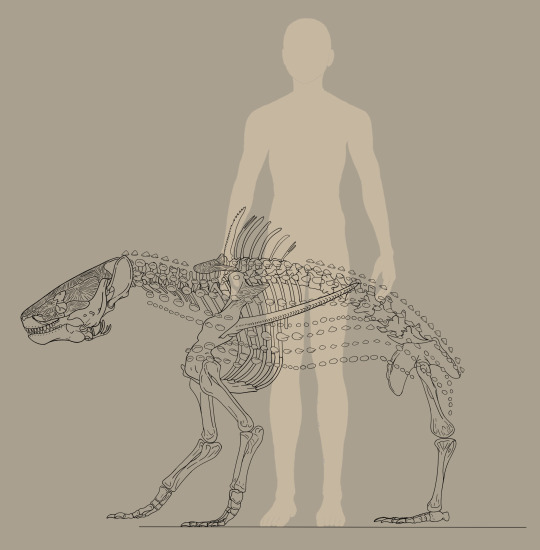
Atterran Terrestrial Catfish (also known as whisker fish) are a lineage of non-teleost fish that have successfully transitioned to terrestrial life, like the ancestors of tetrapods on Earth and Atterra.
Like Earth, the oldest currently known catfish fossils date back to the late cretaceous period of Atterra, which, according to Old World archives, was found in the western continent. While the original fossil was lost during The Fall, the surviving data indicates that the fossil was from a species of armored catfish with similar morphological adaptations to modern-day armored catfish. Atterran biologists theorize catfish evolved between 100-110mya at the beginning of the late Cretaceous period or near the end of the middle Cretaceous period. Unlike the terrestrial teleost fish lineages, the ancestors of the terrestrial catfish did not develop within the hollows of Atterra but instead on the evolved deserts of the surface. These basal catfish would move between bodies of water across the desert sands, like the armored catfish of Brazil, to find food and reproduce. Whenever these fish could not find a suitable body of water, they would hunker down in the mud and hibernate until the wet season arrived, bringing more pools for the fish to inhabit.
Over time, during the late cretaceous, as the desert slowly began to become drier and the catfish had to traverse farther and farther to find suitable pools of water, the catfish's branchial tissue behind their gills slowly became more robust. Taking up larger portions of the body behind the head as the gills began to become smaller from less time spent in water. At the same time, the skin of the ancestral terrestrial catfish became thicker and more resistant to water loss, allowing the catfish to spend more time traversing the dunes in search of water or cool places to hide. Eventually, the armor plating of the ancestor's body became less rigid and sparser, allowing the catfish more flexibility as it raffled across the desert, leading the fish to incorporate its tail into its locomotion and utilize it as a powerful springboard to hop forward. As the catfish's gait and locomotion improved, the brachial tissue moved down into the fish's chest cavity to form primitive lungs. The gill arches began to ossify into the ear and hyoid bones to aid the fish in detecting predators and swallowing food. Alongside the new ear bones, the gill cover slowly became less ossified and flexible to turn into external ears.
Terrestrial catfish are believed to have survived the end cretaceous extinction event on Atterra by being generalists that would eat anything they could fit in their mouths and being just armored enough to ward off many potential would-be predators. Like their ancestors, terrestrial catfish still possess mobile venomous dorsal and pectoral spines to ward off predators should their armored hide prove not enough to deter would-be predators. The stings of terrestrial catfish are excruciating and often cause redness and severe swelling around the area of the sting. In some species, tissue necrosis may also occur, making them a dangerous prey item many predators approach with caution when hunting.
#art#artwork#digital art#drawing#illustration#creature#creature art#creature design#monster design#monsters#fantasy art#my art#drawings#digital 2d#digital illustration#digital drawing#digitalart#clip studio paint#artist#sketches#sketch#doodle#skeleton art#skulls#anatomy#fish#speculative ecology#speculative biology#speculative zoology#speculative evolution
181 notes
·
View notes
Text
Wet Beast Wednesday: bone-eating worm
Happy (almost) Halloween from us at Wet Beast Wednesday. What better to celebrate the spooky holiday than with a spooky animal? These critters are so spooky they even scare skeletons. Sometimes called zombie worms or bone worms, bone-eating worms are scavengers that play an important role in deep seas. Try not to get too scared.
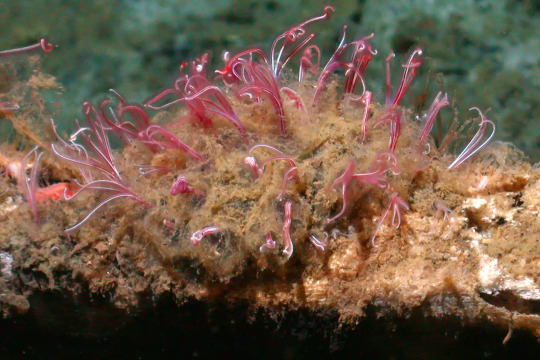
(Image: a cluster of bone-eating worms on a bone. Their plumes are visible, looking like red feathery structures emerging from a clump of brown sludge. End ID)
Bone-eating worms are members of the genus Osedax, with 26 species currently known. My favorite is Osedax mucofloris, which means "bone-eating snot flower". They are small tube worms, reaching between 2.5 and 7 cm (1 to 2.7 in) in length. The body is divided into three segments, the trunk, ovisac, and root. The trunk makes up the majority of the body and it topped by red plumes that act as gills. At the base of the trunk is the ovisac, where eggs are produced. Below that are the roots that bore through the bones the worms live on. This is done by secreting carbonic acid that is produced through anaerobic respiration. The roots also produce a mucus sheath whose purpose is not fully known. It may protect the body from the acid or may prevent the acid from dissolving the hole the worm lives in. As with other tubeworms, the worm generated a protective sheathe to live in. Normally, the plumes extend out of the sheathe to respirate, but when threatened, they will withdraw into the tube.
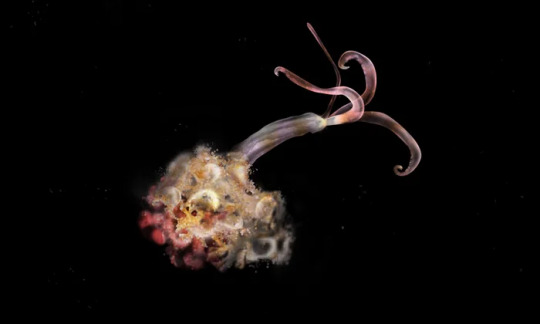
(Image: a bone worm removed from the bone. It is a long, translucent tube with reddish plumes on one and a lump of wavy roots on the other. End ID)
Bone-eating worms lack a mouth, anus, and digestive system. To obtain nutrients, they exist in a symbiotic relationship with bacteria. As the worms break down the bone, they release lipids and proteins that the bacteria consume to produce energy in the form of glycogen, which is transferred to the worm. The worm then uses the glycogen to power itself and feeds it to the bacteria to keep them alive. The worms also use collagen, which is the primary component of bone. Many of the symbiotic bacteria species need the collagen, which the worm provides by breaking down the bone. Curiously, many of the symbionts produce toxins that disrupt the membranes at the roots, leading to infection. The bacteria are also found surviving outside of symbiosis with the worms Because of this, it is debatable whether the relationship between the worm and its bacteria is mutualistic (both parties benefit) or commensal (one party benefits, the other neither benefits nor suffers).
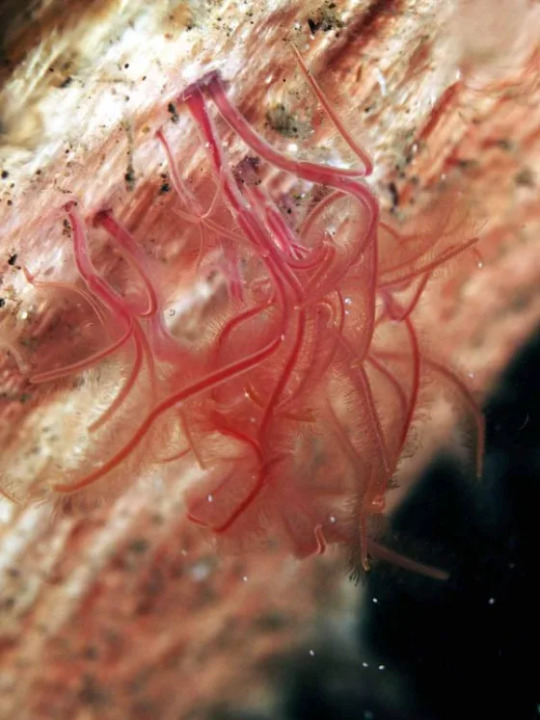
(Image: a cleared view of bone worm plumes emerging from a bone. End ID)
Bone-eating worms are found worldwide in oceanic depths ranging from 10 to 4,200 meters (30 to 14,000 ft). They are most commonly found on the skeletons of whales, but will also colonize fish bones and even, in one experiment, cow bones. Whale bones seem to be preferred both because of their large size and the large quantity of lipids found within. Whale skeletons can often be seen covered with bone worms, giving them the appearance of red shag carpeting. As the worms break down bones, other animals can take better advantage of the nutrients within. The presence of bone worms at a whale fall has been shown to increase the biodiversity of the site. Bone-eating worms are ecosystem engineers, organisms that significantly alter their habitat. They have been doing this since before whales existed. Fossil sea turtle and plesiosaur bones have been found with signs of bone worm colonization.

(Image: a lone bone worm with its tube visible. Its plumes are whitish. End ID)
The bone-eating worms have one of the most dramatic cases of sexual dimorphism in the animal kingdom. All the worms you see when you look at a whale skeleton are females. The males are 20,000 times smaller and fully microscopic. They still resemble larvae, making them a case of neoteny, an adaptation where juvenile characteristics are retained into adulthood. Harems of males live inside the females' tubes and feed on the nutrients released by the bacteria. As the female generates eggs, the males fertilize them. The eggs hatch inside the female's tube and stay for a while to mature before being released into the water. The fact that the worms are so widely distributed indicated that the larvae can travel vast distances to find a new set of bones, but the means they use to do so is unclear. The extreme sexual dimorphism reduces competition between males and females and ensures the males will always have an available mate to pass on their genes. The species Osedax pirapus do not follow this form of dimorphism. Males are still smaller than females, but they actually look like worms and share the same lifestyle. This increases competition between males and females, but ensures that males can make far more sperm due to their greater size.
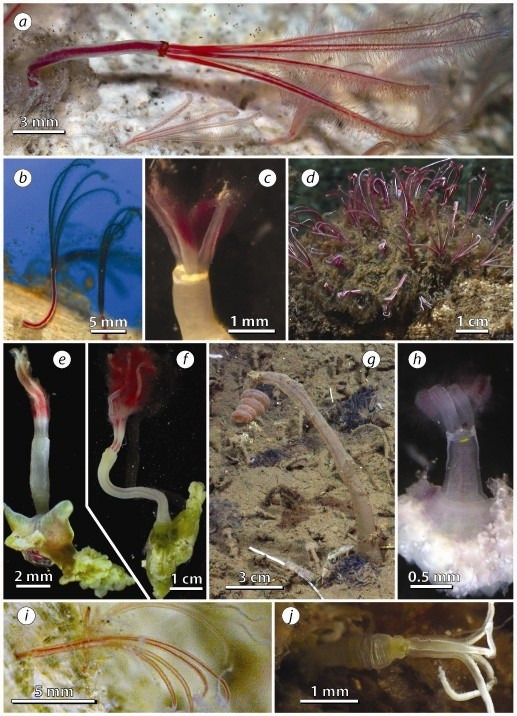
(Image: a collection of images of multiple species of bone-eating worms. Source. End ID)
#BONES FOR THE BONE WORM#wet beast wednesday#bone eating worm#bone worm#zombie worm#osedax#worm#tube worm#polychaete#wormblr#halloween#whale fall#invertebrates#invertiblr#marine biology#marine life#biology#ecology#zoology#animal facts#informative#educational#image described
233 notes
·
View notes
Text

Species of Ichthyosaur Is Largest Known Marine Reptile at 80 Feet Long
A father and daughter duo found the jawbone of the species and the research team named the new marine reptile species Latin for 'giant fish lizard of the Severn.'
A father and daughter, searching for fossils on an English beach, found more than they expected: the jawbone of what may be the largest known marine reptile. Scientists estimate that the giant ichthyosaur, from which the jawbone came, measured 80 feet long and lived during the late Triassic period. A report in the journal PLOS details the find. When Justin Reynolds and Ruby Reynolds (then 11) were combing the beach at Somerset in 2020 and came upon a giant bone chunk, they knew they were on to something. “When Ruby and I found the first two pieces we were very excited as we realized that this was something important and unusual,” said Reynolds in a release. So they contacted Dean Lomax, a University of Manchester paleontologist...
Read more: https://www.discovermagazine.com/the-sciences/species-of-ichthyosaur-is-largest-known-marine-reptile-at-80-feet-long
204 notes
·
View notes
Note
Hi! so far I've loved everything you've written about Kurt, Logan and Remy. 🧎🏻♀️
Could you write something about Kurt? where together with reader they are in the kitchen of the mansion because they can't sleep, and she finally tells him her concerns about the magnitude of her powers and Kurt with his heart of gold tells her beautiful things to calm her down and make her laugh, the rest to your imagination, I would appreciate it, you write great! Thanks 💙✨


SFW! Nightcrawler/Fem!Reader
Ok so I will admit that I made this a leeetle self indulgent. I was trying to think of a power someone could really struggle with and a fun one that I thought of was having necromancy, but having such respect for life and death that it feels wrong. I thought it would fit well with a Kurt fic because it's something that almost feels sacrilegious, and it's good to have a fuzzy blue elf assure you that you aren't a monster :) I know its def not power ambiguous, but I hope this is okay :)
Also, I know my writing style is a little different in this one, And thats because the first few paragraphs set the tone for my writing when I start and tbh I think this one just flowed from my soul to they keyboard.
TWs: nightmares, necromancy, gross descriptions of rotting flesh. Extreme self-doubt and self-consciousness. Basically angst with a happy ending.

You’ve been having nightmares again. They hardly seem to stop, but after a break in between the terror, you'd become too relaxed. Too comfortable. You felt defenseless when they started to begin again.
It’s always the same dream, different font. Bones cracking, flesh ripping as it’s forced into place, natural or not. Skin rotting off of once human bodies, sockets where eyes used to be. It was horrifying. You’d see your family, friends, acquaintances, everyone. Dead. Brought back to life by your power, the power you were still so afraid of. You were always afraid of zombie movies as a kid. Anything rising from the dead, anything breathed back to life in some sick and twisted fantasy. It was ironic that your very own strength was the thing you had always been the most afraid of.
Of course, as you aged and the professor took you in, the fear began to wear off. Mostly, it did. The professor not only taught you how to control your powers but also how to work around your fear. You can remember the confusion you felt when he had set a box of ancient bones in front of you. Fragments of titans, dinosaurs who had long since passed. Bones that would never be matched to an accurate set, parts of them being crushed to dust by the cruelty of time. Bones that only you could breathe to life, to bring them together as a whole again. It was convenient, the professor had told you, that you only needed a fragment to do so. He spoke as if it were a service to them. Most importantly, he brought you a box of bones that weren’t, and never had been, human.
He had taken the fear out of your power. Given you an option you had never considered before. Bones without flesh, without living family. Fossils that would serve you as you were serving them. You were… happy, with that. You were content. You could handle bones. You could revive these ancient skeletons without fear, and fight with them without worry. That didn’t change the horror of knowing the capacity your powers had.
So the nightmares remained, and your sleep had become sparse.
This particular night you were restless. Unable to sleep despite how tired you have been, but it’s hard to rest when there is only terror waiting behind your eyelids. After a while, you decide to give up trying.
The path to the kitchen is one you have memorized, even in the dark. You’ve always been told never to eat sugar before bed, but the only thing you want to comfort you at this moment is hot chocolate- so screw it.
You try your best to be quiet while fishing out a pot out of the cabinets. The stove makes a click as you flick it on, filling the pot with milk before stirring it as it warms. The automatic task is comforting, falling into a routine you enjoy. You’ve just added the coco mix when the sound of a *Bamph* greets you.
“Guten abend.” Kurt whispers, walking over to stand beside you. You give him a tired smile that he returns with a yawn.
“I’m sorry if I woke you.” You say, face returning to a frown Kurt thinks you wear far too often. Maybe it’s good that he’s here because you realize you made far too much of the sweet drink than you had meant to. You get a mug for him, heart fluttering as his hand brushes your own when he takes it from you, thanking you quietly.
“You did not wake me, Schatz. I promise.” Kurt says, pulling out a chair for you with his tail as he sits at the table. You nod silently, placing the pot in the sink and filling it with water before you join him, leaning against his shoulder.
“Did you have another nightmare?” Kurt asks after a moment. His brows are furrowed in concern, and you fail to stop him before he takes a sip from the scalding coco, burning his tongue. He scrunches his nose as he sticks out his tongue, making you giggle for a moment. He thinks your laugh suits you much more than your frown, even if it happens to be at his expense. Your face falls slightly anyway, and he wonders if he could get you to laugh if he did it all over again.
“...No. Not tonight.” The words come out as less than a whisper, and you doubt he might hear it if it weren’t the middle of the night. Little did you know he’d block the world out if he had to, just to hear you speak a little clearer. He hums in response, and you feel his tail slowly wrap snugly around your waist, the very tip idly stroking you in a comforting manner.
“...Do you wish to speak about them?” Kurt asks after a moment. You huff slightly, feeling the hot steam from your mug warm your face as you do so. Still too hot, you think to yourself. Flashes of those horrid nightmares come to mind, and no matter how quickly you try to shake them off, they remain. You choose to think of Kurt instead. Sweet, kind, comforting Kurt. You want to bury yourself in his arms, sink into the feeling of his skin, and never let go, if only he would let you. He would without a second thought, if only you had known. You think carefully about your next words, and the visions of flesh and corpses hardly leave you.
“Am I a monster, Kurt?” You hear a quiet, cut-off gasp from Kurt, and he turns to you. His face is pained, and he sets his mug down to place his hand around your own, still clasped around the hot cocoa.
“Of course not. Only a fool would think so.” His words, although comforting, only leave you with a worse sting in your heart. You can’t hold eye contact with him, staring at the reflection in your mug instead. Only a fool would think so. You halfway wonder if you count as a fool, then.
“I, just… My powers, what I do. What I am capable of doing. It’s not right.” You take a shaky breath in, desperately trying not to break down here and now. “It’s disgusting. It’s horrible. Every time I find myself comfortable with myself I am reminded of what is possible and I spiral. I don’t want it. I don’t-”
“Liebling.” You let out a sob at the sound of his voice. Kurt is hunched over, pressing his forehead against your own as he desperately tries to catch your gaze- but you can’t. You can't bear it, and you close your eyes tightly. Kurt takes the mug from your hands. He cups your face as he wipes your tears, and you feel like even more of a monster as he does so. Sobbing as a man with a heart of gold wipes your tears away with love and care.
“Please, look at me,” Kurt whispers. You try to stop the tears, embarrassed as you fall apart in front of the man you hold so dearly, but it’s hard. It’s so hard. Your chest stings, your throat is sore, you’re sure your nose is running, and yet he still holds you so gently. When your breathing evens out just a bit, you convince yourself to open your eyes again.
Kurt’s gaze is simply concerned. There is no horror, no disgust, nothing but worry for you. Nothing but kindness. You wonder if you could be even half as good as he is.
“You are good. You are kind. You are strong enough to stand by your morals despite the nature of your powers telling you otherwise- and you have the strength to continue to use them and fight your fears anyway. You are one of the most incredible people I have ever met. Do not let your nightmares tell you otherwise.” Kurt’s hold is steady against your cheeks, and your own shaky hands reach up to hold onto his wrists. You sob again as he speaks. You know. You know this. Others have told you, but these words all felt like lies. All but the ones you’re hearing from his mouth. Your tears are slowing, and Kurt leans forward to press a kiss to your forehead, leaving the skin tingling. You whisper quiet apologies for crying, and he shushes each one, gently wiping your face with the soft sleeve of his pajama shirt.
“I would not be here if I didn’t want to care for you, my love,” Kurt says softly. Your eyes widen, taken aback by his words. He called you many things. Liebling. Schatz. Love. But never my love. The words waken butterflies in your belly, and Kurt takes a moment to realize what he’s said. He swallows nervously, but he doesn’t pull away. You don’t either. The two of you are treading a line that you both desperately want to cross.
Kurt is the first to lean in. He does so slowly, toeing the line between you. His gaze remains on your own as he closes the space, nose nuzzling against your own as he gives you the time to back out if you wish. But you don’t. You want nothing more than to have what he is so freely giving.
Kurt kisses you softly, lovingly, and for once the horrors have quieted and are cleared from your mind. All there is now is Kurt, and his soft love. He kisses you a second time before he pulls away, still as close to you as he can be without falling out of his chair. You wonder how he can see beauty where all you see is terror. He wonders if you have any clue just how much of a good person you continue to be.
He knows he would gladly spend the rest of his life showing you.
#x men 97#x men#x men comics#x men 97 x reader#x men headcannons#kurt wagner#kurt wagner x reader#kurt wagner headcannons#nightcrawler headcannons#nightcrawler x reader#xmen nightcrawler#nightcrawler
688 notes
·
View notes
Photo

Fossil Chalk Fish Bones Cretaceous Grey Chalk Osteichthyes Sussex UK Genuine Specimen
Fossil Chalk Fish Bones – Osteichthyes
Geological Period: Cretaceous (Late)
Age: Approximately 100 to 66 million years ago
Formation: Grey Chalk Subgroup
Locality: Clyde, Sussex, United Kingdom
This listing presents a fascinating fragment of fossilised fish bones from a bony fish (class Osteichthyes), embedded in the iconic Grey Chalk of southern England. Recovered from Clyde, Sussex, this specimen dates to the Late Cretaceous, a time when much of the UK was submerged beneath a shallow, warm sea.
The Grey Chalk Subgroup is part of the broader Chalk Group, deposited during the Late Cretaceous and composed primarily of coccolith-rich calcareous sediments. These marine chalks frequently yield well-preserved micro- and macrofossils, including the remains of fish, marine reptiles, ammonites, and echinoderms.
Fish remains from this unit, including bones, scales, and teeth, are relatively scarce and often highly fragmented, making well-preserved examples like this a prized find. The bones may include partial vertebrae, fin rays, or cranial fragments — each offering insights into the structure and diversity of ancient marine vertebrates.
Actual Specimen Pictured: You will receive the exact item shown in the photo.
Scale: 1cm cube included for accurate sizing. Please see image.
Condition: Natural preservation in matrix; stable and suitable for display or study.
Ideal for:
Fossil collectors and palaeontology enthusiasts
Educational settings and museum reference
Marine fossil displays
Gifts for natural history lovers
All of our Fossils are 100% Genuine Specimens & come with a Certificate of Authenticity.
Our fossils are responsibly sourced and described with detailed geological and taxonomic accuracy.
#fossil fish bones#chalk fish fossil#Cretaceous fish remains#Grey Chalk Formation#Sussex fossil#Clyde UK fossil#bony fish fossil#Osteichthyes fossil#British fossil fish#authentic chalk fossil#real fish bones#Mesozoic marine fossil#UK fossil vertebrate#fish bone slab#genuine Cretaceous fossil
0 notes